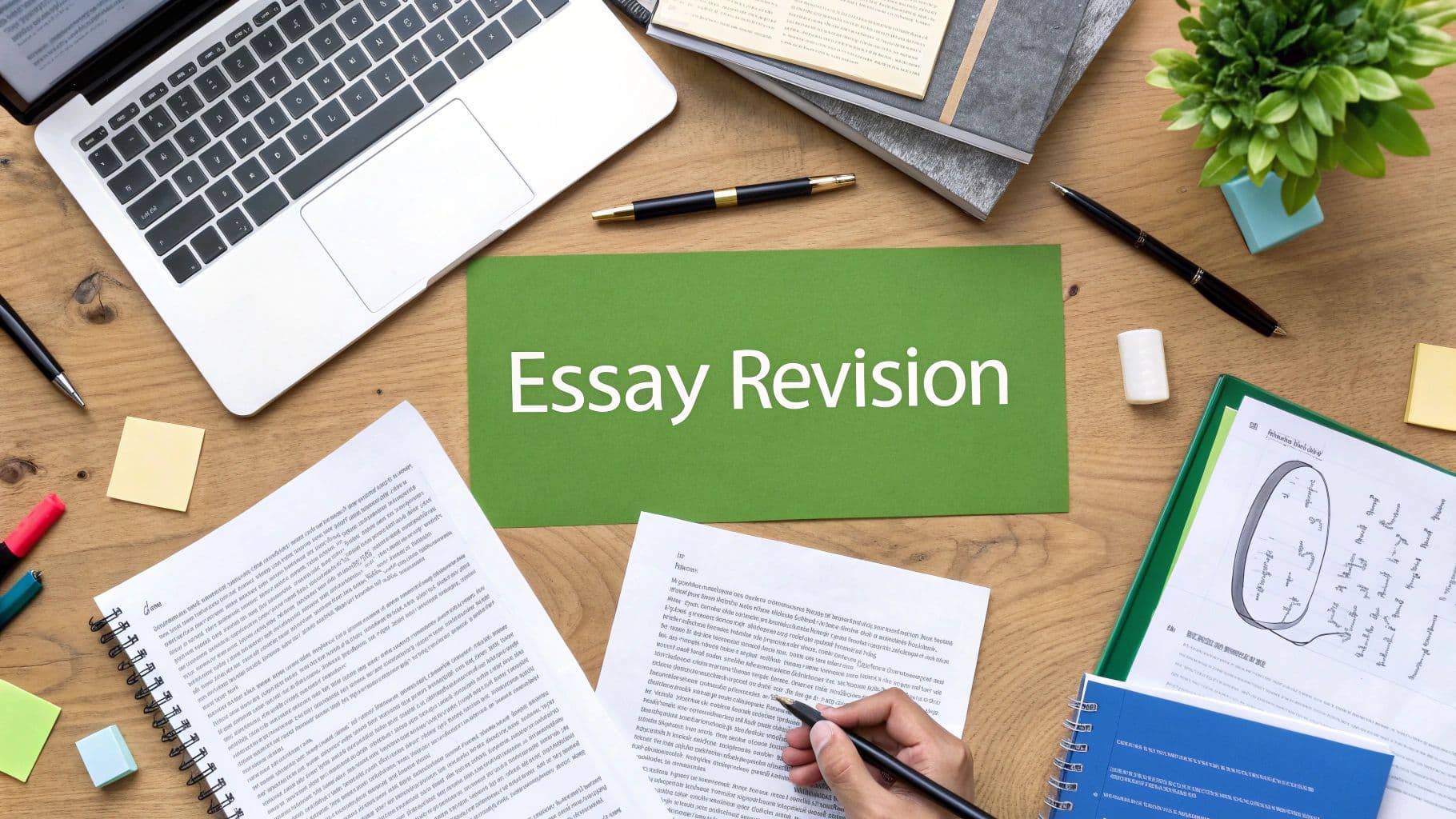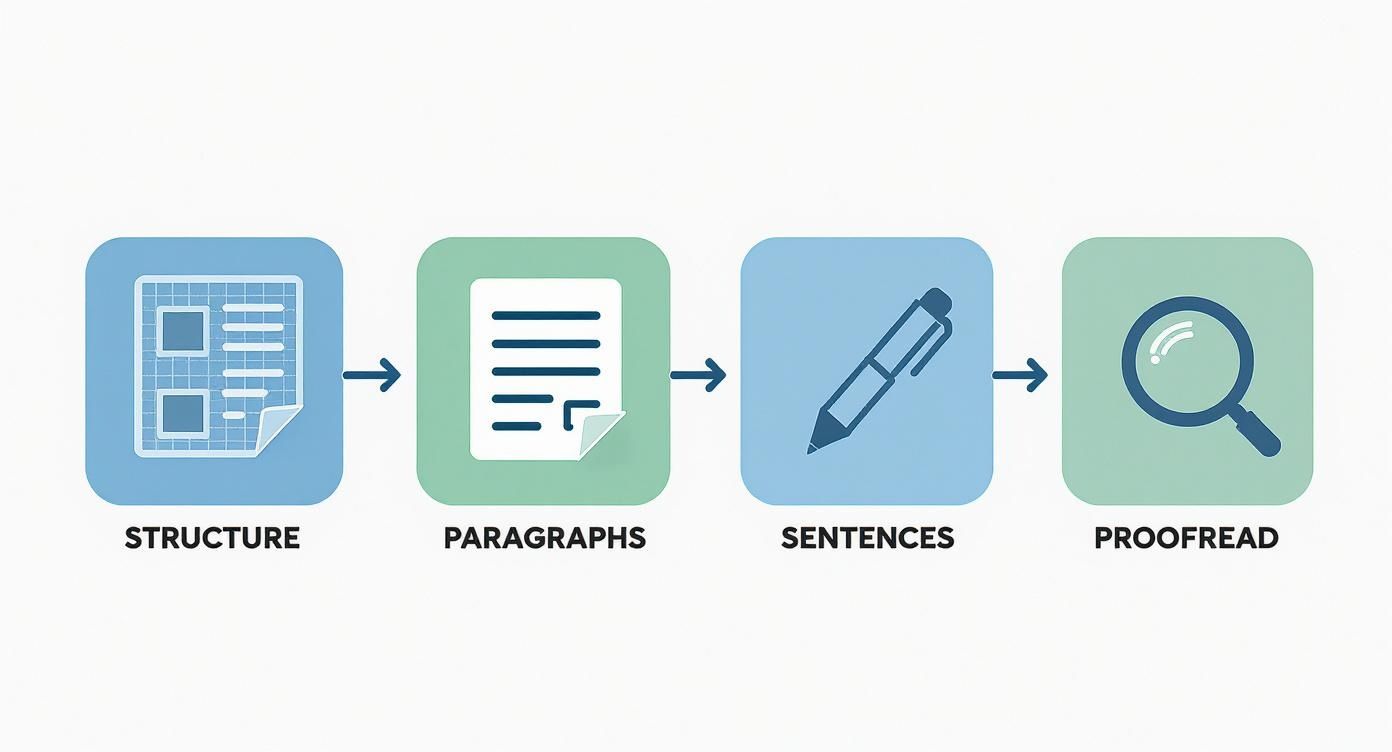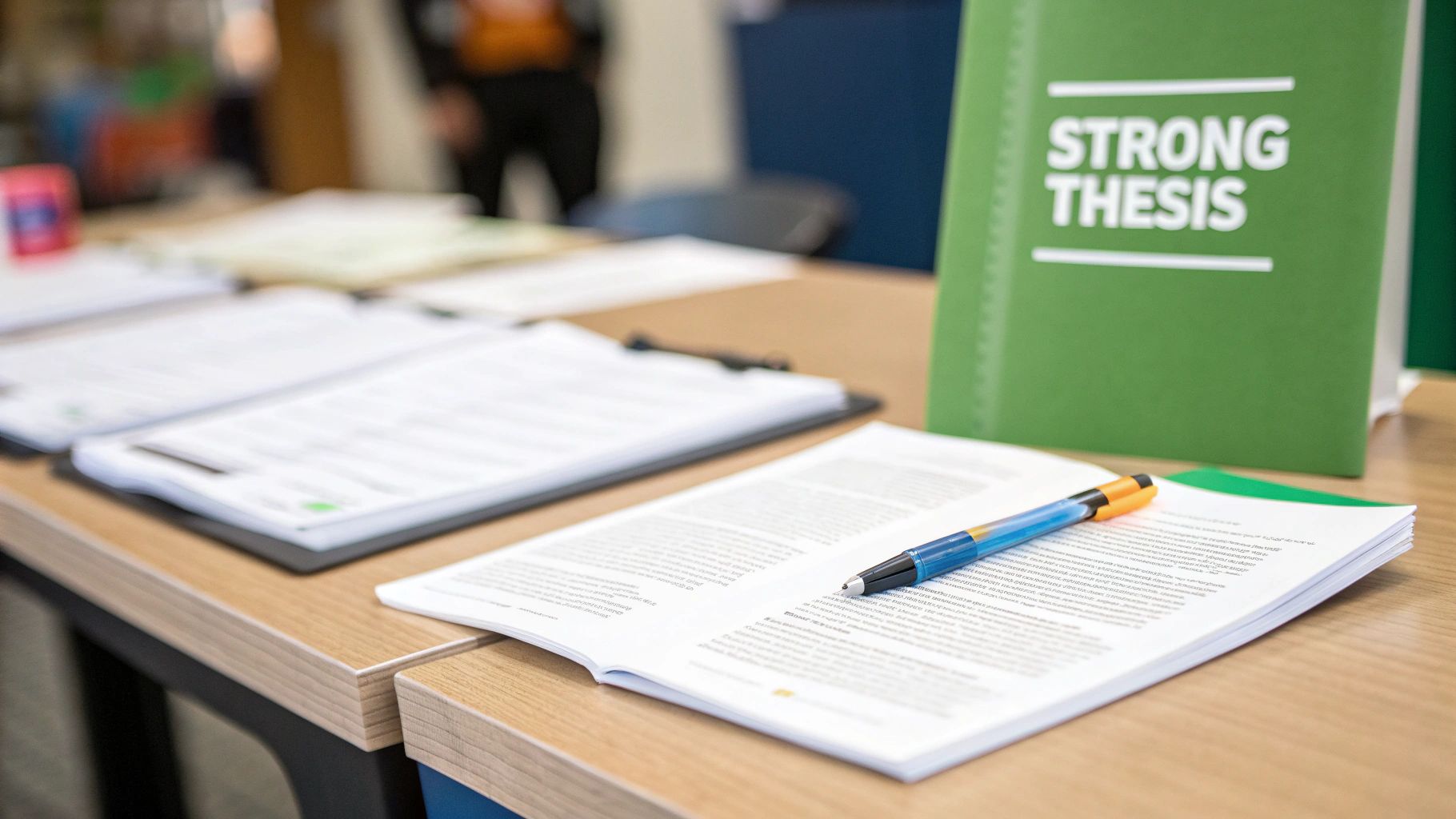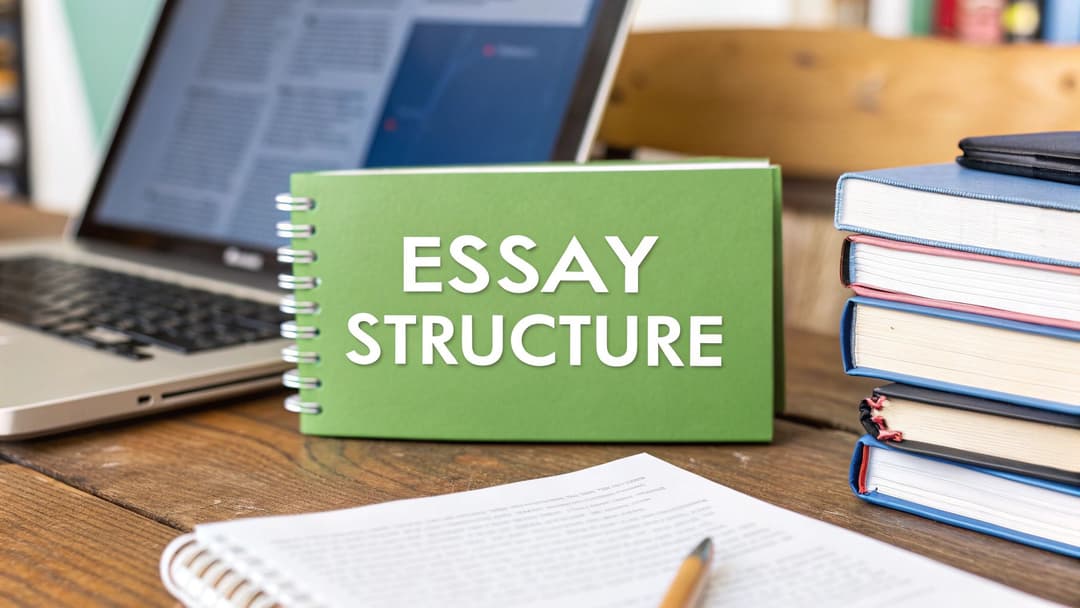
How to Revise an Essay From Good to Great
November 17, 2025
Revising an essay is about more than just cleaning up typos. It's the process of truly re-seeing your work—strengthening your arguments, clarifying your ideas, and sharpening the overall structure. It's how a first draft evolves into something persuasive and polished.
Moving Beyond Proofreading to True Revision
A lot of students think revision just means fixing spelling and commas. That’s proofreading, and while it's definitely important, it should be the very last thing you do.
Real revision is a much deeper process. It’s about taking a hard look at your draft with fresh eyes to see if the core ideas actually work. This is where a good essay becomes a great one.
It’s easy to get lost in tiny grammar edits while massive structural problems go completely unnoticed. A more structured approach works much better. To make sure every part of your essay gets the attention it needs, try implementing effective time management strategies like time blocking. This helps you set aside dedicated time for different layers of editing.
The Multi-Pass Revision Strategy
A multi-pass strategy breaks the huge task of revision into smaller, more manageable layers. You start with the big-picture stuff first—the foundation of your essay—and slowly narrow your focus down to the sentence level.
This way, you’re not wasting an hour perfecting a sentence in a paragraph that you might end up deleting anyway. It’s a smart workflow, and you can explore different writing revision strategies to find what works best for you.
This infographic breaks down the four key passes of a solid revision plan.

As you can see, the process moves from the foundational structure to the surface-level details, which prevents you from spinning your wheels on edits that don't matter yet.
Putting in the time here really pays off. Research has shown that students who spend at least 30% of their total writing time on revision often score up to 20% higher than those who just give their first draft a quick proofread.
The goal isn't just to correct your essay; it's to reimagine it. Each pass offers a new opportunity to make your argument clearer, your evidence stronger, and your voice more compelling. By treating revision as a series of focused sprints, you make the entire process less overwhelming and far more impactful.
Strengthening Your Essay's Core Structure
Before you even think about commas or word choice, your first revision pass needs to be all about the essay's skeleton. This is the big-picture, macro-level edit where you test the strength of your argument's foundation. Ignore the small stuff for now.
Think of it this way: it’s a lot easier to move the walls of a house before you've painted them.
Fixing a weak argument or a jumbled structure at this stage saves you from wasting hours polishing paragraphs that don't even belong in the final draft. Honestly, this is probably the most important part of the entire revision process.

Re-Examine Your Thesis Statement
Your thesis is the engine of your entire essay. Go back and read it—carefully.
Does it make a clear, debatable claim? Or is it just a statement of fact? A factual sentence like, "Shakespeare wrote many plays," offers no room for argument. It's a dead end.
A strong thesis, on the other hand, gives you something to prove. For example, "Shakespeare's later plays reflect a growing disillusionment with monarchical power" is an arguable point you can spend the whole paper defending. If your thesis is weak, everything you build on top of it will be unstable.
Your thesis isn't just a sentence in your intro; it's a promise to your reader. Every single paragraph that follows has to work to fulfill that promise. If a paragraph doesn't directly support, explain, or defend your thesis, it needs to be revised or cut.
Create a Reverse Outline
One of the most powerful revision tools I've ever used is the reverse outline. Don't even look at your original plan. Instead, read through your finished draft and, on a separate document, write down the single main point of each paragraph. Just one sentence per paragraph.
Once you have this list, read it from top to bottom. Suddenly, you have a bird's-eye view of your essay's logical flow.
Now, you get to ask the tough questions about this new outline:
- Is the progression logical? Does each point build naturally on the one before it, or are there awkward jumps?
- Are there any gaps? Can you spot missing steps in your argument that need to be filled in with a new paragraph?
- Is anything out of place? You might notice that the point in paragraph five would be way more effective if it came after paragraph two.
This technique is brilliant at revealing structural weaknesses. You might find two paragraphs making the same exact point, which means you can combine them. Or you might realize a crucial piece of your argument is buried near the end when it should be right up front.
Reorganize Your Essay's Building Blocks
With your reverse outline as your guide, it's time to start moving things around. Think of each paragraph as a Lego brick. Your job is to assemble them in the most stable and coherent way possible.
Don't be afraid to make big changes here. This is the time for bold moves.
Cut and paste entire paragraphs to new locations. If a paragraph doesn't seem to fit anywhere, you have to be ready to delete it—even if you're proud of the writing. This process is about serving the overall argument, not saving a few nice sentences.
By locking down the core structure first, you make sure your logic is sound and your argument is compelling from start to finish. Once that skeleton is strong, you can confidently move on to polishing the details.
Developing Stronger Paragraphs and Arguments
Once your essay's skeleton is solid, it's time to build up the muscle. This pass is all about zooming in on the paragraph level. We’re going to treat each one as a self-contained unit with a single, clear job to do. This is where a bunch of disconnected statements gets forged into a powerful, convincing argument.
Think of every paragraph as a mini-essay. It needs a central idea, solid proof, and your own analysis tying it all back to your main thesis. If the overall structure is the blueprint, your paragraphs are the carefully built rooms inside the house.

Check Every Topic Sentence
The first sentence of any paragraph does some heavy lifting. It's a signpost, telling your reader exactly what that chunk of text is about to prove or explore. A weak topic sentence is a recipe for a rambling, unfocused paragraph.
Try this: read only the first sentence of every paragraph, one after the other. Does that mini-outline make sense? More importantly, does each one make a specific claim that directly supports your thesis? If you need a refresher, our guide on crafting effective topic sentences for body paragraphs can really help nail this down.
Challenge Every Piece of Evidence
So many early drafts are guilty of what I call "drive-by" evidence. The writer drops in a quote or a statistic and then just moves on, hoping the reader makes the connection. Your job now is to be your own harshest critic.
For every piece of evidence you've included, ask yourself one simple, brutal question: "So what?"
- Why does this statistic actually matter?
- What is this quote really proving?
- How does this example make my argument stronger?
If the answer isn't spelled out right there in the paragraph, you’ve got work to do. This is where real analysis comes in. You have to explain the significance of your evidence, connecting it back to the paragraph’s point and, ultimately, to your essay's thesis.
Don’t just present evidence; interpret it. Your voice and analysis are what bridge the gap between a simple fact and a persuasive point. This analytical layer is what demonstrates critical thinking and elevates your writing from a summary to an actual argument.
A Quick Paragraph Revision Checklist
As you move through your draft, keep these three things in mind for every single paragraph. It’s a quick gut check that helps you find the weak spots.
- Unity: Does every sentence in the paragraph stick to the topic sentence? If something feels like it’s veering off-course, either move it to a better spot or just delete it.
- Support: Is the main point backed up with enough credible evidence? Think data, quotes, or specific examples. A single, flimsy piece of evidence won't convince anyone.
- Coherence: Do the sentences flow together smoothly? Use transition words and phrases (“therefore,” “in contrast,” “furthermore”) to guide the reader through your thinking.
By meticulously strengthening each paragraph, you ensure every part of your essay is working hard to support your main idea. This focused pass builds a robust, well-supported argument that’s not just logical, but far more persuasive.
Refining Sentences for Clarity and Impact
Now that your essay's structure is solid and your paragraphs are coherent, it's time to zoom in. We're going to the sentence level, where good writing becomes great writing. This is the final polishing pass, the part where you make sure every single word earns its spot.
Before you touch a single sentence, do this: read your entire essay out loud. I can't stress this enough. Your ears will catch what your eyes skim over—clunky phrasing, awkward rhythms, and repetitive sentence patterns that can lose a reader in a heartbeat. It’s a simple trick, but it's incredibly effective at revealing weak spots in your prose.

Target Passive Voice and Weak Verbs
One of the fastest ways to inject energy into your writing is to hunt down the passive voice. A sentence like, "The decision was made by the committee," feels distant and a little weak. Flip it to the active voice—"The committee made the decision"—and it immediately sounds more direct and confident.
Give your verbs the same intense scrutiny. Are you leaning on weak verbs propped up by adverbs, like "walked slowly"? A stronger, more precise verb often does the work of both words. Think "shuffled" or "ambled." This tightens your writing and paints a much clearer picture.
- Before (Passive): Mistakes were made during the experiment, which were then analyzed.
- After (Active): The researchers made mistakes during the experiment and then analyzed them.
See the difference? That small shift gives the sentence more life. For a deeper dive into making these kinds of improvements, check out our guide on how to rewrite a sentence for greater impact.
Cut Clutter and Eliminate Jargon
Every first draft is filled with fluff. It’s just part of the process. Your job now is to be ruthless. Find those unnecessary words and cut them.
Wordy phrases like "due to the fact that" can just be "because." Adverbs like "very," "really," and "just" are often crutches that add no real meaning. Most of the time, you can delete them and the sentence becomes stronger.
The goal isn't to sound 'smarter' by using complex words; it's to communicate your existing smart ideas as effectively as possible. Simplicity is a sign of confidence in your argument. Unnecessary jargon and overly complex sentences often hide a lack of clarity.
Always look for a simpler way to say something without losing your meaning. Let your ideas shine through the language, don't bury them under it.
Sentence-Level Revision Checklist
Keep this checklist handy as you work through your sentences. It’ll help keep your prose as sharp as your arguments.
- Read it Aloud: Does it sound natural? Does it flow?
- Check for Active Voice: Have you swapped out passive constructions for active ones where it makes sense?
- Strengthen Your Verbs: Can a more precise verb replace a weak verb-adverb combo?
- Eliminate Filler Words: Have you cut all the empty words and phrases?
- Vary Sentence Structure: Are you mixing short, punchy sentences with longer, more detailed ones to create a nice rhythm?
Focusing on these details is what separates a convincing essay from one that's also a pleasure to read. This final pass is all about making sure the language you use is just as powerful as the argument you've built.
Polishing Your Final Draft and Proofreading
You’ve wrestled with your structure, strengthened your paragraphs, and sharpened your sentences. Now it's time for the final, meticulous cleanup.
This last pass isn’t about big ideas anymore. It’s all about hunting down those pesky typos, grammatical slips, and formatting quirks that can undermine all your hard work. This is pure proofreading.
The biggest mistake people make here is trying to proofread right after a long editing session. Your brain is fried. It’s so familiar with the text that it will glide right over obvious errors. The best thing you can do is just step away. Give yourself a few hours, or even better, a full day to get some distance.
Fresh Eyes Find More Mistakes
When you come back to your essay, you need to trick your brain into seeing the words differently. Don't just read it the same way you have a dozen times before.
A simple but surprisingly powerful trick is to change the font or text size. That little visual shift breaks your brain’s pattern recognition, forcing it to slow down and process words one by one instead of in familiar clumps.
Another classic method is to read your essay backward—starting with the very last sentence and working your way to the beginning. This isolates each sentence from its context, making grammatical flaws and typos pop right out.
Proofreading is a focused, technical task. It demands patience and a system. Rushing this final step is like building a beautiful house and forgetting to wash the windows—all the quality work inside is obscured by small, distracting smudges.
Using Tools Wisely in Your Final Check
Digital tools have definitely changed the game for revising essays. The global market for essay writing platforms, which includes advanced revision tools, is projected to shoot past USD 1.1 billion by 2025, largely thanks to AI-powered help. You can discover more insights about this growing market and how it’s shaking things up.
These tools are great assistants for a final check. A good grammar checker can catch a missed comma or a subtle spelling mistake you might have overlooked.
But you can't just set it and forget it. Never rely on them completely. AI can easily misunderstand nuance or context, sometimes suggesting "fixes" that completely change what you meant to say or even introduce new errors.
Always, always do one last, final read-through yourself. This human check ensures your voice remains authentic and your hard work is presented exactly as you intended—professionally and without errors.
Common Questions About Revising an Essay
The revision process can feel a little mysterious, and a few key questions seem to pop up for almost every writer. Nailing down the answers will make your editing flow so much smoother and far less stressful.
One of the biggest questions is always about timing. It’s so tempting to dive straight into revisions the second you type that last word, but honestly, that’s usually a mistake.
Ideally, you want to step away from your essay for at least 24 hours. This little break creates some much-needed mental distance, letting you come back with "fresh eyes." You’ll be amazed at what you notice—flaws in your argument, clunky sentences, or structural gaps that were completely invisible before will suddenly jump right off the page. If you're really crunched for time, even a few hours or just moving to a different room can help reset your perspective.
For students who find it tough to stay focused, especially those with ADHD, certain techniques can make a huge difference. You can discover some proven strategies for focusing with ADHD that will make the entire revision process feel more manageable.
Getting Help from Peers and Tools
Another gray area is getting outside help. How do you get feedback from a friend or classmate that’s actually useful?
The secret is to be specific. Don't just hand it over and ask, "Is this good?" That’s way too broad. Instead, give your reader a mission with targeted questions so you get actionable feedback.
- "Is my main argument in the intro totally clear?"
- "Does the evidence I use in paragraph three actually back up my point?"
- "Could you highlight any sentences that felt confusing or awkward to read?"
This simple shift turns a vague favor into a focused review session. In the same way, AI tools can be helpful, but you have to use them smartly and ethically. They're great for spotting grammar mistakes or suggesting a different way to phrase something. But never use them to cook up your core arguments or rewrite whole sections, and always double-check your school's academic integrity policy.
The single biggest mistake is confusing revision with proofreading. So many students jump right to fixing commas while ignoring huge structural problems. Real revision means re-evaluating your thesis and the flow of your argument first; there’s no point polishing sentences in a paragraph you might cut entirely.
Think of AI as a proofreading sidekick, not a co-author. The critical thinking, the analysis, and the unique voice in your essay? That has to be all you.
Ready to transform your AI-assisted drafts into polished, natural-sounding work? Natural Write helps you humanize your text with one click, ensuring it reads like you wrote it while bypassing AI detection. Preserve your original ideas and refine your writing with confidence. Try Natural Write for free!


